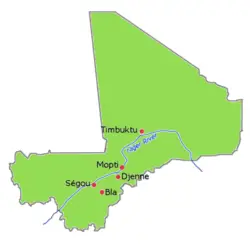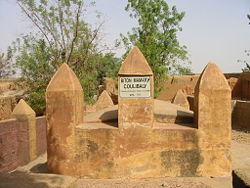Bamana Empire
The Bamana Empire (also Bambara Empire or Ségou Empire) was a large pre-colonial West African state based at Ségou, now in Mali. It was ruled by the Kulubali or Coulibaly dynasty established circa 1640 by Fa Sine also known as Biton-si-u. The empire existed as a centralized state from 1712 to the 1861 invasion of Toucouleur conqueror El Hadj Umar Tall.
The Kulubali Dynasty
In around 1640, Fa Sine became the third Faama (Mande word for King) of a small kingdom of Bambara people in the city of Ségou in Mali. Though he made many successful conquests of neighboring tribes and kingdoms, he failed to set up significant administrative framework, and the new kingdom disintegrated following his death (c. 1660).
In the early 18th century, Mamari Kulubali (sometimes sited as Mamari Bitòn) settled in Ségou and joined an egalitarian youth organization known as a tòn. Mamari soon reorganized the tòn as a personal army, assumed the title of bitòn, and set about subduing rival chiefs. He established control over Ségou, making it the capital of a new Bambara Empire.
Fortifying the capital with Songhai techniques, Bitòn Kulubali built an army of several thousand men and a navy of war canoes to patrol the Niger. He then proceeded to launch successful assaults against his neighbors, the Fulani, the Soninke, and the Mossi. He also attacked Tomboctou, though he held the city only briefly. During this time he founded the city of Bla as an outpost and armory.
Mamari Kulubali was the last ruler to be called Bitòn. All future rulers were simply titled Faama. Bakari, the first Faama after Mamari reigned from (1710-1711). Faama De-Koro ascended in 1712 reigning until 1736. The kingdom had three more faamas with unstable 4-year reigns until falling into anarchy in 1748.
The Ngolosi
In 1750, a freed slave named Ngolo Diarra seized the throne and re-established stability, reigning for nearly forty years of relative prosperity. The Ngolosi, his descendants, would continue to rule the Empire until its fall. Ngolo's son Mansong Diarra took the throne following his father's 1787 death and began a series of successful conquests, including that of Tomboctou (c. 1800) and the Massina region.
Economy and structure
The Bambara Empire was structured around traditional Bambara institutions, including the kòmò, a body to resolve theological concerns. The kòmò often consulted religious sculptures in their decisions, particularly the four state boliw, large altars designed to aid the acquisition of political power.
The economy of the Bambara Empire flourished through trade, especially that of the slaves captured in their many wars. The demand for slaves then led to further fighting, leaving the Bambara in a perpetual state of war with their neighbors.
Mungo Park, passing through the Bambara capital of Ségou two years after Diarra's 1795 death, recorded a testament to the Empire's prosperity:
| “ | The view of this extensive city, the numerous canoes on the river, the crowded population, and the cultivated state of the surrounding countryside, formed altogether a prospect of civilization and magnificence that I little expected to find in the bosom of Africa.[1] | ” |
Jihad and fall
At the Battle of Noukouma in 1818, Bambara forces met and were defeated by Fula Muslim fighters rallied by the jihad of Cheikou Amadu (or Seku Amadu) of Massina. The Bambara Empire survived but was irreversibly weakened. Seku Amadu's forces decisively defeated the Bambara, taking Djenné and much of the territory around Mopti and forming into a Massina Empire. Timbuktu would fall as well in 1845.
The real end of the empire, however, came at the hands of El Hadj Umar Tall, a Toucouleur conqueror who swept across West Africa from Dinguiraye. Umar Tall's mujahideen readily defeated the Bambara, seizing Ségou itself on March 10, 1861, forcing the population to convert to Islam, and declaring an end to the Bambara Empire (which effectively became part of the Toucouleur Empire).
See also
- Bambara language: a Mande language, spoken by 6 million people in Mali.
- Bambara people: an ethnic group who represen %40 of Mali's population.
- Kaarta, another Bambara kingdom of the same epoch
ReferencesISBN links support NWE through referral fees
- Davidson, Basil. Africa in History. New York: Simon & Schuster, 1995.
Further reading
- Djata, Sundiata A. K. The Bamana Empire by the Niger: Kingdom, Jihad and Colonization 1712-1920. Princeton, NJ: Markus Wiener Publishers, 1997. ISBN 1-55876-131-4.
- Condé, Maryse. Segu. Penguin Books, 1996. ISBN 978-0140259490.
External links
- Timeline of Western Sudan
- Pre-colonial Malian History (French language)
- Segu Kingdom rulers, from Host Kingdoms
- Mali traditional states from World Statesman
- Epics about the Segou Kingdom
Notes
- ↑ Quoted in Davidson, p245.
Template:Mali topics
br:Rouantelezh Bambara Segou de:Bambara (Reich) fr:Royaume bambara de Ségou id:Kekaisaran Bamana ru:Бамбара (государство) uk:Держави Бамбара
Credits
New World Encyclopedia writers and editors rewrote and completed the Wikipedia article in accordance with New World Encyclopedia standards. This article abides by terms of the Creative Commons CC-by-sa 3.0 License (CC-by-sa), which may be used and disseminated with proper attribution. Credit is due under the terms of this license that can reference both the New World Encyclopedia contributors and the selfless volunteer contributors of the Wikimedia Foundation. To cite this article click here for a list of acceptable citing formats.The history of earlier contributions by wikipedians is accessible to researchers here:
The history of this article since it was imported to New World Encyclopedia:
Note: Some restrictions may apply to use of individual images which are separately licensed.

